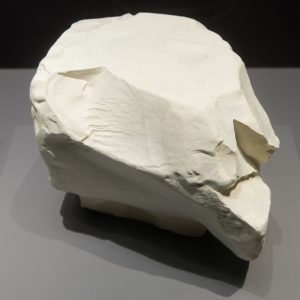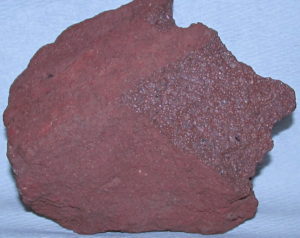3.4.1: Luster
- Page ID
- 19163
\( \newcommand{\vecs}[1]{\overset { \scriptstyle \rightharpoonup} {\mathbf{#1}} } \)
\( \newcommand{\vecd}[1]{\overset{-\!-\!\rightharpoonup}{\vphantom{a}\smash {#1}}} \)
\( \newcommand{\dsum}{\displaystyle\sum\limits} \)
\( \newcommand{\dint}{\displaystyle\int\limits} \)
\( \newcommand{\dlim}{\displaystyle\lim\limits} \)
\( \newcommand{\id}{\mathrm{id}}\) \( \newcommand{\Span}{\mathrm{span}}\)
( \newcommand{\kernel}{\mathrm{null}\,}\) \( \newcommand{\range}{\mathrm{range}\,}\)
\( \newcommand{\RealPart}{\mathrm{Re}}\) \( \newcommand{\ImaginaryPart}{\mathrm{Im}}\)
\( \newcommand{\Argument}{\mathrm{Arg}}\) \( \newcommand{\norm}[1]{\| #1 \|}\)
\( \newcommand{\inner}[2]{\langle #1, #2 \rangle}\)
\( \newcommand{\Span}{\mathrm{span}}\)
\( \newcommand{\id}{\mathrm{id}}\)
\( \newcommand{\Span}{\mathrm{span}}\)
\( \newcommand{\kernel}{\mathrm{null}\,}\)
\( \newcommand{\range}{\mathrm{range}\,}\)
\( \newcommand{\RealPart}{\mathrm{Re}}\)
\( \newcommand{\ImaginaryPart}{\mathrm{Im}}\)
\( \newcommand{\Argument}{\mathrm{Arg}}\)
\( \newcommand{\norm}[1]{\| #1 \|}\)
\( \newcommand{\inner}[2]{\langle #1, #2 \rangle}\)
\( \newcommand{\Span}{\mathrm{span}}\) \( \newcommand{\AA}{\unicode[.8,0]{x212B}}\)
\( \newcommand{\vectorA}[1]{\vec{#1}} % arrow\)
\( \newcommand{\vectorAt}[1]{\vec{\text{#1}}} % arrow\)
\( \newcommand{\vectorB}[1]{\overset { \scriptstyle \rightharpoonup} {\mathbf{#1}} } \)
\( \newcommand{\vectorC}[1]{\textbf{#1}} \)
\( \newcommand{\vectorD}[1]{\overrightarrow{#1}} \)
\( \newcommand{\vectorDt}[1]{\overrightarrow{\text{#1}}} \)
\( \newcommand{\vectE}[1]{\overset{-\!-\!\rightharpoonup}{\vphantom{a}\smash{\mathbf {#1}}}} \)
\( \newcommand{\vecs}[1]{\overset { \scriptstyle \rightharpoonup} {\mathbf{#1}} } \)
\( \newcommand{\vecd}[1]{\overset{-\!-\!\rightharpoonup}{\vphantom{a}\smash {#1}}} \)
\(\newcommand{\avec}{\mathbf a}\) \(\newcommand{\bvec}{\mathbf b}\) \(\newcommand{\cvec}{\mathbf c}\) \(\newcommand{\dvec}{\mathbf d}\) \(\newcommand{\dtil}{\widetilde{\mathbf d}}\) \(\newcommand{\evec}{\mathbf e}\) \(\newcommand{\fvec}{\mathbf f}\) \(\newcommand{\nvec}{\mathbf n}\) \(\newcommand{\pvec}{\mathbf p}\) \(\newcommand{\qvec}{\mathbf q}\) \(\newcommand{\svec}{\mathbf s}\) \(\newcommand{\tvec}{\mathbf t}\) \(\newcommand{\uvec}{\mathbf u}\) \(\newcommand{\vvec}{\mathbf v}\) \(\newcommand{\wvec}{\mathbf w}\) \(\newcommand{\xvec}{\mathbf x}\) \(\newcommand{\yvec}{\mathbf y}\) \(\newcommand{\zvec}{\mathbf z}\) \(\newcommand{\rvec}{\mathbf r}\) \(\newcommand{\mvec}{\mathbf m}\) \(\newcommand{\zerovec}{\mathbf 0}\) \(\newcommand{\onevec}{\mathbf 1}\) \(\newcommand{\real}{\mathbb R}\) \(\newcommand{\twovec}[2]{\left[\begin{array}{r}#1 \\ #2 \end{array}\right]}\) \(\newcommand{\ctwovec}[2]{\left[\begin{array}{c}#1 \\ #2 \end{array}\right]}\) \(\newcommand{\threevec}[3]{\left[\begin{array}{r}#1 \\ #2 \\ #3 \end{array}\right]}\) \(\newcommand{\cthreevec}[3]{\left[\begin{array}{c}#1 \\ #2 \\ #3 \end{array}\right]}\) \(\newcommand{\fourvec}[4]{\left[\begin{array}{r}#1 \\ #2 \\ #3 \\ #4 \end{array}\right]}\) \(\newcommand{\cfourvec}[4]{\left[\begin{array}{c}#1 \\ #2 \\ #3 \\ #4 \end{array}\right]}\) \(\newcommand{\fivevec}[5]{\left[\begin{array}{r}#1 \\ #2 \\ #3 \\ #4 \\ #5 \\ \end{array}\right]}\) \(\newcommand{\cfivevec}[5]{\left[\begin{array}{c}#1 \\ #2 \\ #3 \\ #4 \\ #5 \\ \end{array}\right]}\) \(\newcommand{\mattwo}[4]{\left[\begin{array}{rr}#1 \amp #2 \\ #3 \amp #4 \\ \end{array}\right]}\) \(\newcommand{\laspan}[1]{\text{Span}\{#1\}}\) \(\newcommand{\bcal}{\cal B}\) \(\newcommand{\ccal}{\cal C}\) \(\newcommand{\scal}{\cal S}\) \(\newcommand{\wcal}{\cal W}\) \(\newcommand{\ecal}{\cal E}\) \(\newcommand{\coords}[2]{\left\{#1\right\}_{#2}}\) \(\newcommand{\gray}[1]{\color{gray}{#1}}\) \(\newcommand{\lgray}[1]{\color{lightgray}{#1}}\) \(\newcommand{\rank}{\operatorname{rank}}\) \(\newcommand{\row}{\text{Row}}\) \(\newcommand{\col}{\text{Col}}\) \(\renewcommand{\row}{\text{Row}}\) \(\newcommand{\nul}{\text{Nul}}\) \(\newcommand{\var}{\text{Var}}\) \(\newcommand{\corr}{\text{corr}}\) \(\newcommand{\len}[1]{\left|#1\right|}\) \(\newcommand{\bbar}{\overline{\bvec}}\) \(\newcommand{\bhat}{\widehat{\bvec}}\) \(\newcommand{\bperp}{\bvec^\perp}\) \(\newcommand{\xhat}{\widehat{\xvec}}\) \(\newcommand{\vhat}{\widehat{\vvec}}\) \(\newcommand{\uhat}{\widehat{\uvec}}\) \(\newcommand{\what}{\widehat{\wvec}}\) \(\newcommand{\Sighat}{\widehat{\Sigma}}\) \(\newcommand{\lt}{<}\) \(\newcommand{\gt}{>}\) \(\newcommand{\amp}{&}\) \(\definecolor{fillinmathshade}{gray}{0.9}\)Luster refers to the general appearance or sheen of a mineral. It refers to the way in which a mineral reflects light.
For a very good discussion, with examples, of many different mineral lusters, watch the video linked below:
Video 3-3: Examples of mineral lusters (7 minutes)
3.4.1.1 Metallic and Submetallic Lusters
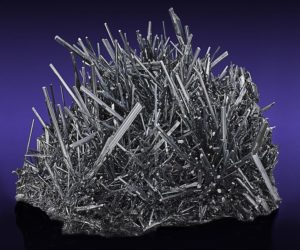
Minerals that have the shiny appearance of polished metal are said to have a metallic luster. Some could be used as mirrors. Well-crystallized pyrite is a good example. Other commonly metallic minerals include chalcopyrite (CuFeS2), bornite (Cu5FeS4), native copper (Cu), native gold (Au), hematite (Fe2O3), and magnetite (Fe3O4). The photo seen here (Figure 3.22) shows metallic stibnite (Sb2S3). The crystal cluster is almost a meter across! Most of minerals with a metallic luster are sulfides, oxides, or native elements.
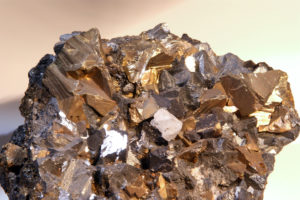
Minerals that do not appear metallic have a nonmetallic luster. Those that appear only partially metallic are called submetallic. The chalcopyrite (CuFeS2; gold-bronze color) seen in this photo is metallic, the minor dark grey sphalerite (ZnS) in the photo might be considered submetallic, and the hard-to-pick-out fluorite (CaF2) (semi-clear and white) is nonmetallic. Other commonly submetallic minerals include, cinnabar (HgS), and cuprite (Cu2O).
3.4.1.2 Nonmetallic Lusters
Mineralogists use many terms to describe nonmetallic lusters. The table below lists the most commonly used terms.
| Terms Used to Describe Luster of Nonmetallic Minerals | ||
| luster | meaning | example minerals |
| vitreous | having a glassy appearance | quartz, tourmaline |
| resinous | having the appearance of resin | sphalerite, sulfur |
| greasy | reflecting light to give a play of colors; similar to oil on water | chlorite, nepheline |
| silky | having surfaces appearing to be composed of fine fibers | chrysotile (asbestos), gypsum |
| adamantine | having a bright brilliant appearance similar to that of diamonds | diamond, cerussite |
| pearly | appearing iridescent, similar to pearls or some seashells | muscovite, talc |
| dull | not reflecting significant amounts of light or showing play of colors | kaolinite (clay), niter |
Vitreous Minerals
Vitreous minerals are nonmetallic minerals that have a glassy appearance. The adjective is derived from the Latin vitrium, meaning glass. Quartz (SiO2) is an excellent example. Calcite (CaCO3), topaz (Al2SiO4F2), and fluorite (CaF2) are other minerals that may be vitreous. The two photos below show vitreous calcite and topaz.
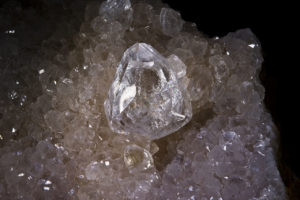
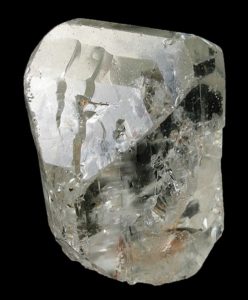
Resinous Minerals
Resinous minerals have a luster similar to violin resin or pine pitch. The most common mineral example is a resinous variety of sphalerite (ZnS) such as that shown in the photo below (Figure 3.26). Sphalerite, however, has other appearances. In fact, the name sphalerite is from the Greek sphaleros which means deceiving or treacherous. This name refers to the many different appearances that sphalerite may have. Its luster can be metallic, submetallic, resinous or adamantine. Some samples are transparent with a vitreous luster.

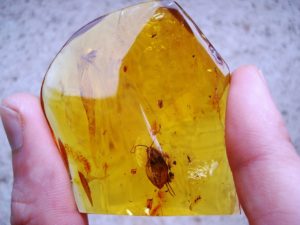
The photo on the right above shows resinous amber, which is fossilized tree resin, with an insect inclusion. Amber, however, is a biomineral, not a true mineral.
Greasy Minerals
Greasy minerals show a play of color – color change with angle of view – that resembles grease or maybe fat. Examples are the opal and cordierite seen in the two photos below. Besides opal and cordierite, jadeite and a few other minerals sometimes have a greasy luster. However, this luster occurs most commonly in opal (a mineraloid) and in minerals that contain many small inclusions.
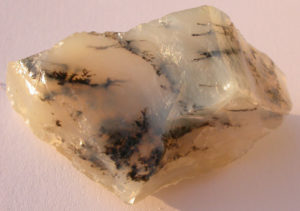
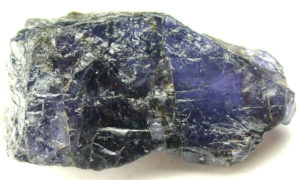
A good short discussion of play of color can be found at:
Silky, Fibrous, and Acicular Minerals
Silky minerals appear to have a parallel arrangement of fine fibers, sometimes giving them the luster of silk. Satin spar, in the photo on the left below, is a variety of gypsum (CaSO4•2H2O). It gets its name from its fibrous appearance and silky sheen.
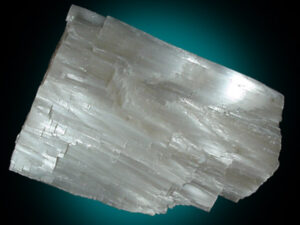
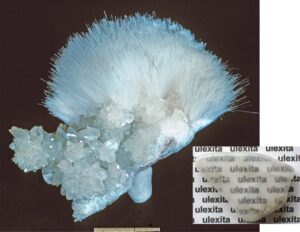
If fibers are coarse, we may describe a mineral as fibrous instead of silky. Ulexite, a hydrated borate mineral shown in the photo on the right above, is a classic example of a fibrous mineral. In the large photo, the acicular (needle-like) ulexite fibers are radiating from a cluster of blocky colemanite (a different borate mineral).
Mineral fibers occasionally display the same optical properties that characterize fiber optics – they transmit light. The inset in Figure 3.31 shows a variety of ulexite called TV-rock because it transmits images of what is behind it – in this case, writing. The fibers in this specimen cannot be seen but are all parallel and perpendicular to the page.
Adamantine Minerals
We use the term adamantine to describe crystals that sparkle or appear brilliant; diamond (C) is perhaps the best-known example. But, Herkimer diamonds, a variety of quartz (SiO2) from Herkimer, New York can also be adamantine. The two photos below show a Herkimer diamond and a real diamond. Other minerals that are sometimes adamantine include anglesite (PbSO4), cerussite (PbCO3), and corundum (Al2O3). Some synthetic minerals, including cubic zirconia (ZrO2) are also adamantine. All these natural and synthetic stones can have their sparkle enhanced with proper faceting.
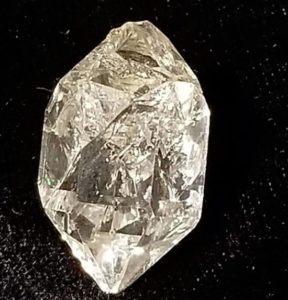
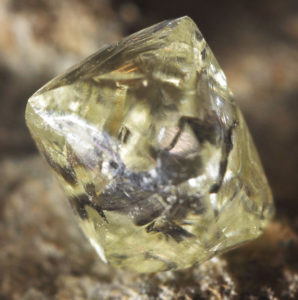
Pearly Minerals
Pearly minerals show a play of color that resembles the luster of pearls. Light reflecting from pearly minerals may be white or appear to have washed out rainbow colors. The play of colors is due to a layered atomic arrangement, so pearly minerals generally have excellent planar cleavage. The two photos below show pearly muscovite and talc. These minerals are somewhat dichroic, which means their colors change with angle of view. But, that property cannot be seen in standard photos.
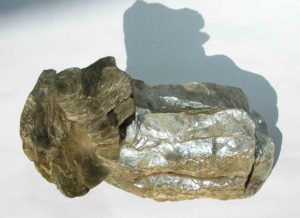

Dull and Earthy Minerals
Dull minerals show no remarkable luster – because they have non-reflective surfaces. Kaolinite (Figure 3.36, below) is a good example – it is usually a fine-grained aggregate of small grains, white, and drab. Besides kaolinite, the other clay minerals, such as montmorillonite or illite, also have dull lusters.
We say that dull minerals are earthy if they have a brownish or reddish color resembling dirt. Common hematite is an excellent example (although some hematite may be metallic). The hematite seen in the photo below (Figure 3.37) can be described as being earthy, and Figure 3.14 showed another example of earthy hematite. Besides hematite, limonite and other metal oxides and hydroxides are commonly earthy.
